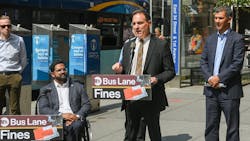MTA to begin issuing bus lane violations for blocking bus stops and doubling parking
Vehicles blocking bus stops or double parking will no longer be warned by the Metropolitan Transportation Authority (MTA) starting Aug. 19. Offenders will receive summonses in the mail starting at $50 and scaling up to $250 for repeat violators. This is in addition to existing enforcement of cars blocking bus lanes on 14 bus routes equipped with Automated Camera Enforcement (ACE) that captures vehicles violating bus lanes and bus stop rules, double parking and bus stop rules in real-time across four boroughs, with Staten Island to be added later this year.
According to the MTA, when enforcement cameras are activated, on average, routes see bus lane speeds increased by five percent, a 20 percent reduction in collisions and a five to 10 percent estimated reduction in emissions. The agency notes only nine percent of drivers commit another bus lane violation after being fined. All 623 buses on the 14 routes that currently feature lane enforcement technology on bus lanes have now upgraded capability to enforce bus stops and double-parked locations.
Enforcing vehicles parked in bus stops helps ensure buses can pull to the curb, allowing all customers to safely exit and board the bus, including those using wheelchairs or mobility devices and those pushing strollers or carts. ACE builds on the many accessibility improvements New York City (NYC) Transit has made to its bus fleet since 1993 when it became the first large public transit agency to have a 100 percent wheelchair accessible fleet.
“New Yorkers deserve buses that can keep up with the hustle and grind at the heart of this city,” said New York City Department of Transportation (NYCDOT) Commissioner Ydanis Rodriguez. “We know automated enforcement changes driver behavior, with more than 80 percent of bus lane blockers never receiving more than one ticket. The warning period is over; now it’s time for faster and safer bus routes across the five boroughs.”
“Millions of New Yorkers depend on a safe and reliable bus operation to navigate the city,” said MTA Chief Accessibility Officer Quemuel Arroyo. “With the activation of ACE today, we can all look forward to clearer bus lanes resulting in faster commutes for all riders who use our buses to get to work, school and to reach all corners of the city.”
The ACE program is administered in partnership with the NYCDOT and the New York City Department of Finance. Once captured by the cameras, video, images, license plate, location and time stamp information, the information is then transmitted to NYCDOT for review and processing. Since 2019, NYCDOT has issued 438,660 notices of violations. By the end of 2024, there will be 1,023 ACE equipped buses across 33 routes.
“ACE is the key to enhancing bus service, speed and safety,” said NYC Transit Interim President Demetrius Crichlow. “Thanks to the efforts of NYC Transit workers and our partners at NYCDOT, we can improve the commutes of millions of bus riders.”
“Time is up for folks who are inconveniencing bus passengers by blocking buses and bus stops,” said NYC Transit Senior Vice President of Buses Frank Annicaro. “Now that Automated Camera Enforcement has been activated, we will hold drivers accountable for blocking bus lanes, double parking in bus paths and blocking bus stops.”
